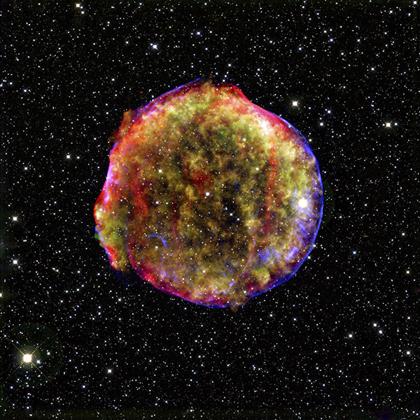
A false multi-color image of the Type Ia supernova remnant, Tycho. The image is a composite of an X-ray image taken by the orbiting Chandra X-ray Observatory, an infrared image taken by the orbiting Spitzer Space Telescope, and an optical image taken by the 3.5-meter Calar Alto telescope located in southern Spain . The expanding gas cloud is extremely hot, while slightly different expansion speeds have given the cloud a puffy appearance.
Supernovae are the explosive deaths of massive stars. These cataclysms disburse into space all of the chemical elements that were spawned inside the progenitor stars, while adding to them, through the explosion, most of the elements above iron in the periodic table. Chemical enrichment of the universe alone makes supernovae immensely important contributors to the cosmic ecosystem, and objects of intense study.
The class of supernova called "Type Ia" offer yet another powerful advantage. These objects are produced when a dense, evolved star has a large companion star that gradually spills material onto the evolved star's surface. Once the mass of the compact star exceeds a fixed, relatively well-defined limit, gravity triggers its explosive demise. Type Ia supernovae are thus thought to be "standard candles," and are used by astronomers to estimate the distances to remote galaxies whose supernovae appear faint because they are far away: they are the calibrators for our cosmic distance scale. But precisely because they are far away, some skeptics have argued that these supernovae are different in ways that make them unreliable calibrators.
In an effort to get the best possible calibration, astronomers try to understand all the possible ways these supernova can erupt. The spectra of supernovae contain many diagnostic signatures of the physical processes underway. CfA astronomers Ryan Foley, Stefanie Blondin, Peter Challis, Bob Kirshner, Chris Stubbs, and Michael Wood-Vasey together with nineteen colleagues have completed four years of spectroscopic studies of distant supernovae in what they term the ESSENCE project. Their analysis of 329 spectra from 274 supernovae found 118 of the Type Ia variety, many of them observed well after the peak in their brightnesses, and all of them at distances from earth ranging from 2.6 to 9 billion light-years.
The essential conclusion from this study was that the spectra of these distant Type Ia supernovae were broadly consistent with those of their much nearer counterparts. This result means that classification schemes are relatively reliable, and that criticisms of the distance calibration based on arguments that remote SN are different are in general unfounded.